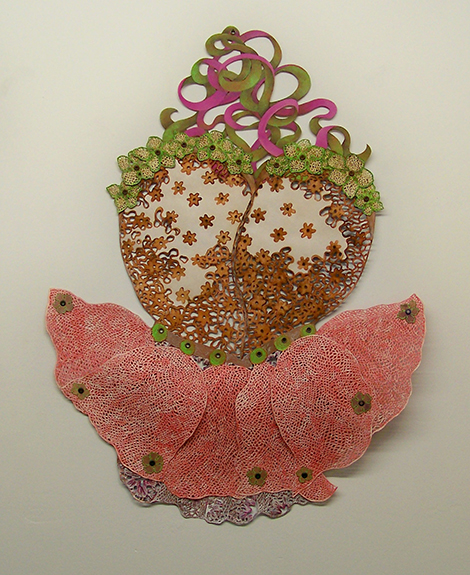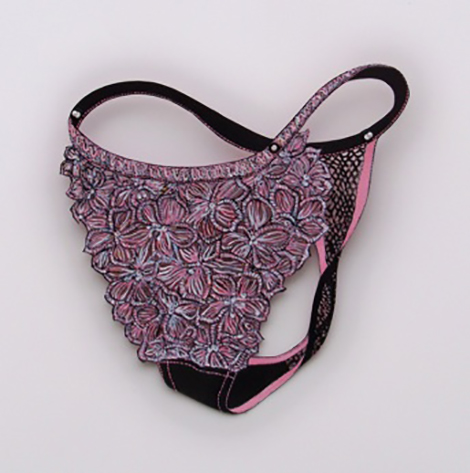Our clothes are, as Virginia Woolf reminds us, more than “vain trifles” serving “to merely keep us warm.” Instead, as Woolf asserts, “They change our view of the world and the world’s view of us.” Art that turns our attention to our clothes illuminates how we see each other and how we are seen.
Leigh Salgado uses paper, paint and grommets to depict women’s clothes, especially lace-lined lingerie: bras, panties, corsets. Her cut-paper portrayals of women’s undergarments have roots in both the high art of the European avant-garde and the craft practice of papel picado.
In the late 1940s, Matisse began cutting shapes from painted paper and reassembling them, like puzzle pieces, into flat decorative images. In doing so, he turned away from oil painting—the privileged medium of high Modernism—to explore the previously devalued craft activity of cut paper. The merger of fine art and craft (also termed high and low art) was to become a fundamentally important strategy of Postmodernism.
A Southern California native, Leigh Salgado grew up seeing papel picado images adorning the walls of Mexican restaurants and houses of her Latino neighbors, especially during the Day of the Dead celebrations, but she never thought to incorporate the craft tradition into her art practice. Then one day in 1990, she became frustrated by certain parts of a painting she was working on, and decided to excise the offending sections. She found she liked the cutouts and they have since become major components of her compositions. Today, the sheets of paper Salgado employs are riddled with piercings, recalling papel picado. The rhythmically cut holes also recall the eyelet lace that adorns dresses, blouses and lingerie.
One of Salgado’s recent works, Blissful Deflowering (2015) at first seems to be a globular vase filled with a dense bouquet of pointed-petal blossoms. On second glance, it becomes an orange-striped brassiere supporting flesh-toned flowers symbolic of female virginity.
Floral imagery also dominates Ballerina, (2015) a dance costume with hot pink petals that constitute a tutu. The torso is sprinkled with tiny brown flowers and topped by lacy green leaves. Above the torso is a scrambled ribbon that shimmers magenta and emerald. Ballerina asks viewers to consider the culture of performative display enacted by women on and off the stage.
Good and Plenty (2013) portrays thong panties in the signature colors of the licorice candy of that name. The fabric over the pubis is composed of pink and black striped blossoms; the tiny back section is openwork, like fishnet. The technical control Salgado exhibits is gasp-inducing, especially in the fishnet area. Like the licorice, the panties look good enough to eat… which of course brings up all manner of sexual innuendos.
In short, Salgado’s exquisitely wrought, visually seductive depictions of female attire address the objectification of women and how we co-create that objectification by seeing and dressing ourselves as objects. Lingerie, especially, contributes to what Simone de Beauvoir discusses as woman’s state of being seen (with man the viewer). Salgado insists we reconsider this process.




















0 Comments